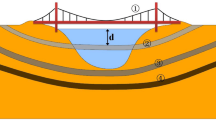Abstract
Floating offshore wind turbines (FOWTs) are generally positioned by mooring systems including embedded anchoring foundations and mooring lines. The mooring line consists of three portions: the embedded portion, the lying portion and the suspended portion. Previous studies ignore the embedded and lying portion, and assume the lower end of the suspended chain is fixed at the touchdown point on the seabed. However, the effect of the chain–seabed interaction plays a more important role, especially in the dynamic response of the mooring chain. This article proposes a numerical model for the dynamic response of the mooring chain, considering the dynamic interaction between the mooring chain and the clay and sand sediment. Firstly, the configuration and tension of the mooring chain under monotonic motion of the fairlead are verified against the static model and then the response of the chain under cyclic horizontal drift and vertical heave of the floating facility is investigated. It was found that the chain gradually digs into the deeper soil and become straightened within a few cycles. The dig-in effect leads to the cyclic degradation of the mooring chain tensions and uplift angle at the padeye. The development in the configuration, tension, and angle of the mooring chain under horizontal and vertical motion in clay and sand sediments are compared in this study in order to give practical advice. The effects of embedment depth and soil shear strength are also evaluated.



























Similar content being viewed by others
References
Ablow CM, Schechter S (1983) Numerical simulation of undersea cable dynamics. Ocean Eng 10:443–457
ANSYS (2010) ANSYS AQWA user’s manual. Canonsburg: ANSYS, Inc.
API. RP 2SK (2005) Design and analysis of station keeping systems for floating structures. Washington, DC: American Petroleum Institute
Degenkamp G, Dutta A (1989) Soil resistances to embedded anchor chain in soft clay. J Geotech Eng 115(10):1420–1438
European Wind Energy Association (2013) Deep water: the next step for offshore wind energy: a report by the European Wind Energy Association. Brussels: European Wind Energy Association
Gault JA, Cox WR (1974) Method for predicting geometry and load distribution in an anchor chain from a single point mooring buoy to a buried anchorage. Houston: Offshore Technology Conference
Gobat JI, Grosenbaugh MA (2006) Time-domain numerical simulation of ocean cable structures. Ocean Eng 33(10):1373–1400
Howell CT (1992) Investigation of the dynamics of low-tension cables [PhD dissertation]. Woods Hole: Massachusetts Institute of Technology and Woods Hole Oceanographic Institution Joint Program
Koh CG, Zhang Y, Quek ST (1999) Low-tension cable dynamics: numerical and experimental studies. J Eng Mech 125:347–354
Mortensen N (2015) Chain configuration in sand, theory and large scale field testing. In: Meyer V, editor. Frontiers in offshore geotechnics III. Vol. 2. Boca Raton: CRC Press
Neubecker SR, O’Neill MP (2004) Study of chain slippage for embedded anchors. Houston: Offshore Technology Conference
Neubecker SR, Randolph MF (1995) Profile and frictional capacity of embedded anchor chains. J Geotech Eng ASCE 121:797–803
Norwegian Geotechnical Institute (NGI) (2006) Configuration of embedded mooring lines: theory manual and verification. Oslo: Norwegian Geotechnical Institute
Orcina (2014) OrcaFlex user manual. Version 9.8 a. Orcina, Cumbria
Reese LC, Beard RM (1973) A design method for an anchor pile in a mooring system. Houston: Offshore Technology Conference
Terzaghi K, Peck RB, Mesri G (1996) Soil mechanics in engineering practice. 3rd ed. New York: Wiley
Wang LZ, Guo Z, Yuan F (2010a) Three-dimensional interaction between anchor chain and seabed. Appl Ocean Res 32:404–413
Wang LZ, Guo Z, Yuan F (2010b) Quasi-static three-dimensional analysis of suction anchor mooring system. Ocean Eng 37:1127–1138
Wang LZ, Shen KM, Li LL, Guo Z (2014) Integrated analysis of drag embedment anchor installation. Ocean Eng 88:149–163
Wilson BW (1960) Characteristics of anchor cables in uniform ocean currents. Technical Report no. 204-1. College Station: A & M College of Texas
Wung CC, Litton RW, Mitwally HM, Bang S, Taylor RJ (1995) Effect of soil on mooring system dynamics. Houston: Offshore Technology Conference
Xiong L, Yang J, Zhao W (2016) Dynamics of a taut mooring line accounting for the embedded anchor chains. Ocean Eng 121:403–413
Yen BC, Tofani GD (1984) Soil resistance to stud link chain, Proceedings of 16th Annual Offshore Technology Conference, OTC 4769. Houston: Offshore Technology Conference
Zhao Y, Liu H (2016) Numerical implementation of the installation/mooring line and application to analyzing comprehensive anchor behaviors. Appl Ocean Res 54:101–114
Acknowledgements
The authors are grateful for the support received from the International Science & Technology Cooperation program of China (2015DFE72830), National Natural Science Foundation of China (grant no. 51325901, 51209183), Zhejiang Provincial Natural Science Foundation of China (LY15E090002) and Fundamental Research Funds for the Central Universities (2015QNA4023).
Author information
Authors and Affiliations
Corresponding author
Rights and permissions
About this article
Cite this article
Shen, K., Guo, Z. & Wang, L. Prediction of the whole mooring chain reaction to cyclic motion of a fairlead. Bull Eng Geol Environ 78, 2197–2213 (2019). https://doi.org/10.1007/s10064-018-1300-z
Received:
Accepted:
Published:
Issue Date:
DOI: https://doi.org/10.1007/s10064-018-1300-z




